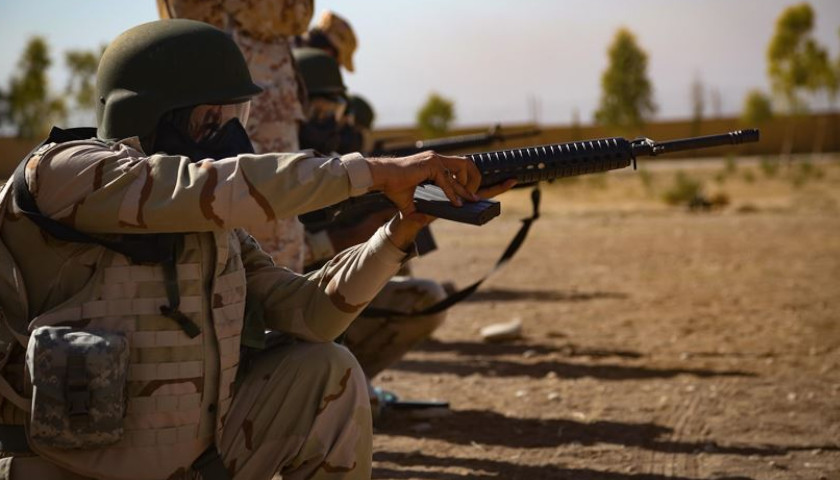U.S. President Donald Trump declared the end of the Islamic State terror group’s self-declared caliphate Friday, saying the terror group had been “100 percent defeated” —a claim that was quickly refuted by U.S.-backed forces on the ground.
Trump made the announcement following a briefing from Acting Defense Secretary Pat Shanahan aboard Air Force One en route to Florida. Trump then showed reporters onboard a map with no IS presence in Syria.
“The territorial caliphate has been eliminated in Syria,” added White House spokeswoman Sarah Sanders.
At its height in 2014, IS ruled over large swaths of Syria and Iraq, boasting dual capitals in Raqqa, Syria, and Mosul, Iraq.
Since then, the U.S.-led international coalition, along with partners on the ground, have rolled back the terror group’s hold.
The very last territory under IS control — a couple of scraps of land in the northeastern Syrian town of Baghuz — began to slip through the terror group’s grip for good late Thursday into early Friday, after the U.S.-led coalition launched a new wave of airstrikes targeting the remaining IS-held positions.
But shortly after Trump’s announcement, SDF spokesman Mustafa Bali told VOA’s Kurdish Service he could not confirm IS’s defeat, as his forces were still engaged with IS fighters in Baghuz and those additional airstrikes were being carried out as he spoke.
“Heavy fighting continues … to finish off whatever remains of ISIS,” Bali tweeted later, using an acronym for the terror group.
Earlier Friday, SDF officials warned that despite the series of airstrikes that began late Thursday night, several hundred IS fighters were still battling U.S.-backed forces in Baghuz.
Both SDF and coalition officials have also been wary that unknown numbers of IS fighters could still be lurking in trenches and in a complex system of caves and tunnels.
The tunnels, which are thought to run for at least two kilometers, helped hide tens of thousands of IS fighters and their families through much of the early part of the SDF offensive. And officials said there are indications certain tunnels may even extend into neighboring Iraq.
The London-based Syrian Observatory for Human Rights said just within the past day or so U.S.-backed forces encountered a group of more than 300 IS fighters in one of the caves and had to call in airpower.
The SDF has been wary of declaring victory over IS in Baghuz, pointing to numerous predictions of the terror group’s ultimate demise over the past several months that all proved to be premature.
But Trump has repeatedly predicted IS’s demise, telling reporters just this past Wednesday the caliphate would be “gone by tonight” even though fighting persisted.
“For political reasons, he wants to declare victory,” said Heritage Foundation Middle East analyst Jim Phillips. “I think his statements are aimed at a domestic, American audience.”
As well as that message may be received by Trump’s supporters, however, there are deep-seated concerns that mistaking the collapse of the caliphate with the end of IS could be costly.
“The same conditions that led to the rise of ISIS and before that to the rise of al-Qaida in Iraq are still present in the region,” said Phillips, adding the U.S. likely will need to “remain poised to intervene with air power, perhaps with commandos.”
U.S. defense and intelligence officials are likewise concerned.
“We view this as a strategic shift,” a senior defense official said. “This is really that transition point, that inflection point from ISIS holding physical control of an area to something that comes after.”
The biggest worry: upwards of 60,000 people, including more than 5,000 IS fighters, who have surrendered or been captured since the SDF and coalition launched their final assault last month.
“These folks are unrepentant,” the official said. “The seeds for a future caliphate, or certainly a persistent clandestine insurgency, exist in these large numbers of people who … are looking to reposition for future perpetuation of ISIS in some form or fashion.”
U.S. officials also warn that most of the group’s senior leadership, including self-declared caliph, Abu Bakr al-Baghdadi, remain at large, commanding at minimum “tens of thousands” of fighters and supporters across Syria and Iraq.
And even in the face of imminent defeat, IS’s true believers remain defiant.
“Those who are bewildered and think that our caliphate is over … we will say that it’s remaining and expanding,” a fighter from Baghuz, identifying himself as Abu al-Harith al-Ansari, said in a video released Thursday and translated by the SITE Intelligence Group.
“The banner has been elevated, and the Ummah, whose sons are racing to martyrdom, does not know defeat,” he said.
– – –
Patsy Widakuswara and the VOA Kurdish service contributed to this report.
Photo “US Military” by Army Sgt. Lisa Soy.




